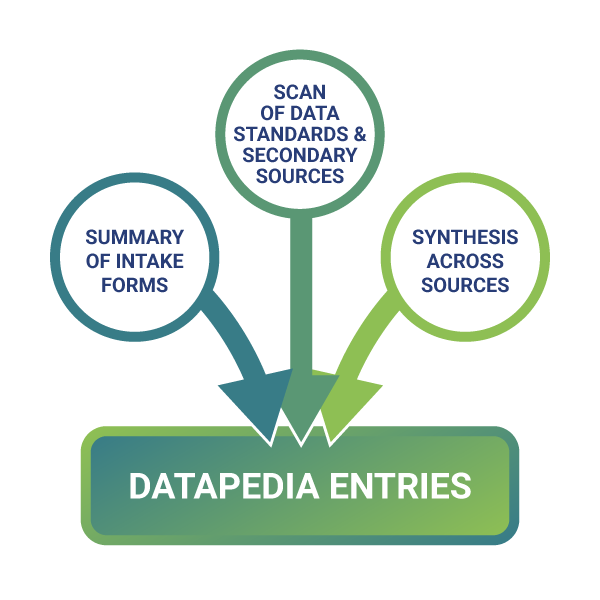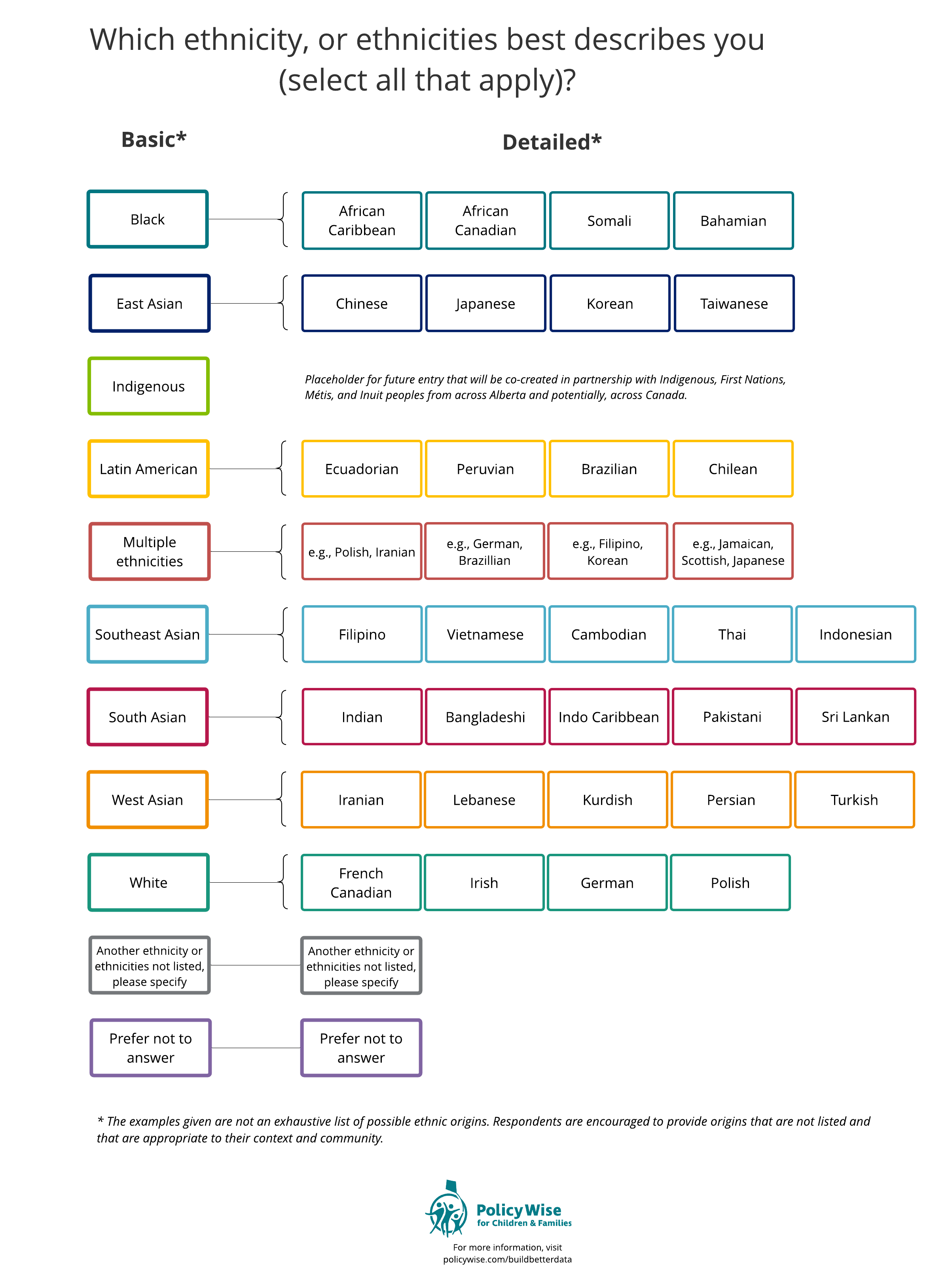Demographic Datapedia Entry:
Ethnicity
Each Datapedia entry begins with definition(s) of the demographic variable followed by some considerations and limitations of the variable for understanding populations of people.
Next, a suggested question(s) and response options are shown. Note that this is given as guidance rather than a prescription of what’s best as that will depend on the information needs and context of your organization. Also included are ideas and examples of how to ask questions about the demographic variable in conversation.

Plan
It’s important to invest time in seeking out your “Why?” with data to ensure the data collected support your information needs. For more on this, see the Plan section of the Data Lifecycle.
Finally, a diagram is shown to illustrate basic, detailed, and comprehensive response options for the variable.
- The basic options are the minimum set of response options that are suggested for each variable.
- The detailed and comprehensive categories illustrate more detailed and nuanced response options that may be important to consider depending on your information needs and organization’s context.
- The diagram of response options show how each category can be collapsed into the basic set of answers. For example, the detailed and comprehensive response options can be collapsed or aggregated into the basic response options for analysis.
- Consider all response options when deciding on which category best suits your organization’s needs.
Importantly, the suggestions and details of the response options will need to be revisited and revised periodically to reflect shifts and changes that may emerge in various variables over time.1

BUILD
For ideas on how to collect and record quality data see the Build section of the Data Lifecycle.
2.1 Definition
A. Ethnicity refers to groups that are characterized by a shared culture, language, or nationality. When asking about ethnicity, it is important to tease apart what specifically about ethnicity is being asked, for example, ethnic identity (i.e., an individuals’ sense of affiliation and relatedness to a particular ethnic group), or bilingualism (i.e., what languages a person speaks).2
2.2 Considerations and Limitations
Ethnicity can be used to understand:
- Which ethnic groups are, or are not, being served.3
- How programming may need to be adapted to reflect the ethnic diversity of participants e.g., clients may have more than one ethnic affiliation and how that effects services.3
- How to inform aspects of operational planning or reporting such as that may be required by funders.3
Ethnicity cannot be used to understand:
- Nationality or citizenship because nationality refers to the country of citizenship. Nationality is sometimes used to mean ethnicity, although the two are technically different. People can share the same nationality but be of different ethnic groups and people who share an ethnic identity can be of different nationalities.
- Place of birth or origin which may or may not be the same as a person’s nationality.
- Race. Race is a historically derived construct that categorizes individuals by their physical characteristics of skin colour, hair texture, and behavioural characteristics.4 Critically, “National, religious, geographic, linguistic and cultural groups do not necessarily coincide with racial groups: and the cultural traits of such groups have no demonstrated genetic connection with racial traits.” 5
- The language(s) a person speaks or is most comfortable using for communication. Languages can be spoken by anyone regardless of their country of origin, e.g., many Canadians speak French but do not have French cultural origins.
- Cultural identity because cultural practices may vary within ethnicities.6
Additional Considerations:
- Why ask in the first place?
-
-
- To support data collection for use in understanding who is being served and to creating strong human rights and human resources strategies for organizations in the public, private, and non-profit sectors.7
- Organizations within Alberta are engaged in research and data collection to identify and understand the human rights issues impacting communities.8
-
-
- To support service delivery consider asking questions around:9
-
-
- Cultural considerations.
- A combination of asking about both place of birth, and primary language spoken at home can help illuminate how best to support clients.
-
-
- Some people have more than one ethnic background. Allowing multiple selections instead of a generic “mixed ethnicities” option provides more accurate information.10
- It is important to give options that best represent the communities being served. This could mean that the organization lists options based on definitions of ethnicity and/or place of birth11. A few resources that could be helpful to compile these lists are:
-
-
- Statistics Canada12
- Ontario Antiracism Directorate13
- United Nations List of Member States14 (does not include, Taiwan, The Cook Islands, Niue, the Holy See, and the State of Palestine)
-
-
2.3 Suggested Collection Methods
The minimum suggested data collection method, or “basic” option reflects a synthesis of practices, considerations from nonprofit stakeholders, and recognized standards in capturing demographic data. The suggested method is modeled after what might be asked on an intake form during an initial meeting with a client. The process by which intake or registration occurs can vary widely depending on the context within which you are working. For example, the way questions are asked and data are recorded will vary for clients in crises, as compared to walk-in or drop-in sessions, or when registering for a program that requires people to meet certain eligibility requirements. In those cases, the suggested collection method can be used as a starting point but adapted to fit the needs of the context within which the data are being collected.
As a standard practice we suggest always including an option for people to write in an answer that may not fit within the options provided, along with an option not to answer. These are both important for creating inclusive demographic questions.1, 15, 16
2.3.1 Basic Question(s)
1. What ethnicity, or ethnicities, best describes you (select all that apply)?
- Black
- East Asian
- Indigenous
- Latin American
- Multiple ethnicities
- Southeast Asian
- South Asian
- West Asian
- White
- Another ethnicity or ethnicities not listed, please specify: __________________
- Prefer not to answer
2.3.2 Diagram of Response Options
The diagram shows an overview of the basic, detailed and comprehensive response options. The options are not necessarily exhaustive, but they are modeled after what organizations may want to provide depending on the needs and context of their work. As a standard practice we suggest always including an option for people to write in an answer that may not fit within the options provided, along with an option not to answer. These are both important for creating inclusive and demographic questions.1, 15, 16 The question can be found at the top of the diagram and the response choices are mapped into the basic, detailed, and comprehensive levels. Not all variables warrant all levels of response options.

COLLECT
For considerations on building trust and relationships through data collection see the Collect section of the Data Lifecycle.


LENSES
You may wish to approach your data collection work through the lens of a particular framework or set of guiding principles, which will shape how you think about your response options. For more details, see the Lenses section of the Data Lifecycle.
To create the diagram for variable responses, two main sets of sources were used.
- Organization intake and registration forms from nonprofit subsectors across Alberta.
- Best practices in data collection, academic literature of demographic data, and resources from data aggregators (e.g., Statistics Canada, National Institutes of Health).
Findings from these sources were synthesized and organized across three levels of response options: basic, detailed, and comprehensive. To learn more please see the full methods. Datapedia Project Approach and Acknowledgements.pdf
Footnotes
Frederick, J. K. (2020, November 18). Four strategies for crafting inclusive and effective demographic questions. Ithaka S+R Blog. https://sr.ithaka.org/blog/four-strategies-for-crafting-inclusive-and-effective-demographic-questions/
Betancourt, H. & Lopez, S. (1993). The study of culture, ethnicity, and race in American psychology. American Psychologist, 48, 629-637. https://doi.org/10.1037/0003-066X.48.6.629
Canadian Institute for Health Information. (2020, July 24). Proposed standards for race-based and Indigenous identity data collection and health reporting in Canada. https://www.cihi.ca/sites/default/files/document/proposed-standard-for-race-based-data-en.pdf
Markus, H. R. (2008). Pride, prejudice, and ambivalence: Toward a unified theory of race and ethnicity. American Psychologist, 63(8), 651–670. https://doi.org/10.1037/0003-066X.63.8.651
UNESCO (1950). The race question. UNESCO and its programme, 3(31), 1-11. https://unesdoc.unesco.org/ark:/48223/pf0000128291
Loue S. (2013) Cultural and Ethnic Differences. In: Gellman M.D., Turner J.R. (eds) Encyclopedia of Behavioral Medicine. Springer, New York, NY. https://doi.org/10.1007/978-1-4419-1005-9_174
Ontario Human Rights Commission. (2009, November 26). Count me in! Collecting human rights-based data. www.ohrc.on.ca/en/count-me-collecting-human-rights-based-data
Alberta Human Rights Commission. (2017, December). Your voice: Advancing human rights in Alberta. https://albertahumanrights.ab.ca/media/5xyiioqm/your-voice-advancing-human-rights-in-alberta.pdf
Dragan, A. (2009, December). The importance of addressing linguistic ethno-cultural diversity in the delivery of public health services: a literature review. Region of Peel. http://portal.peelregion.ca/health/resources/pdf/adriana.pdf
Government of Ontario. (2018, May 2). Anti-racism data standards – Order in Council 897/2018. www.ontario.ca/page/anti-racism-data-standards-order-council-8972018
Multicultural Health Brokers Coop (December, 2020). Collecting race-based and ethnicity data: Laying the foundations for racial equity in policy and practice [white paper]. Edmonton, AB.
Statistics Canada. (2020, July 20). Ethnic or cultural origins: Technical report on changes for the 2021 Census. https://www12.statcan.gc.ca/census-recensement/2021/ref/98-20-0002/982000022020001-eng.cfm#a7
Government of Ontario. (2020, November 19). Data standards for the identification and monitoring of systemic racism. https://www.ontario.ca/document/data-standards-identification-and-monitoring-systemic-racism
United Nations. (n.d.). Member states. https://www.un.org/en/member-states/
Fernandez, T., Godwin, A., Doyle, J., Verdin, D., Boone, H., Kirn, A., Benson, L., & Potvin, G., (2016). More Comprehensive and Inclusive Approaches to Demographic Data Collection. School of Engineering Education Graduate Student Series, 60. http://docs.lib.purdue.edu/enegs/60
Lesbian, Gay, Bisexual, & Transgender Equity Center. (n. d.). Good practices: Demographic data collection. University of Maryland. https://lgbt.umd.edu/good-practices-demographic-data-collection
Do you have additions to suggest to the Datapedia? Or, do you want to learn more about working with data?
We’d love to hear from you. Contact us at info@policywise.com.



